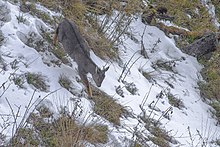| Himalayan goral | |
|---|---|

| |
| Male and female Himalayan gorals in Pangolakha Wildlife Sanctuary, India | |
| Conservation status | |
 Near Threatened (IUCN 3.1) | |
| CITES Appendix I (CITES) | |
| Scientific classification | |
| Domain: | Eukaryota |
| Kingdom: | Animalia |
| Phylum: | Chordata |
| Class: | Mammalia |
| Order: | Artiodactyla |
| Family: | Bovidae |
| Subfamily: | Caprinae |
| Genus: | Naemorhedus |
| Species: | N. goral |
| Binomial name | |
| Naemorhedus goral (Hardwicke, 1825) | |

| |
| Range map | |
The Himalayan goral (Naemorhedus goral) or the gray goral, is a bovid species native to the Himalayas. It is listed as Near Threatened on the IUCN Red List because the population is thought to be declining significantly due to habitat loss and hunting for meat.
Characteristics

The Himalayan goral is 95 to 130 cm (37 to 51 in) in length and weighs 35–42 kg (77–93 lb). It has a gray or gray-brown coat with tan legs, lighter patches on its throat, and a single dark stripe along its spine. Males have short manes on their necks. Both males and females have backward-curving horns which can grow up to 18 cm (7.1 in) in length. In addition to certain peculiarities in the form of the skull, gorals are chiefly distinguished from the closely related serows in that they do not possess preorbital glands below their eyes, nor corresponding depressions in their skulls.
Distribution and habitat
The Himalayan goral occurs in the Himalayas from Pakistan, Nepal, Bhutan, southern Tibet, and the states of Sikkim and Arunachal Pradesh in India to possibly western Myanmar. It most commonly occurs from 900 to 2,750 m (2,950 to 9,020 ft) above sea level, but has been recorded in Pakistan at elevations of 1,000 to 4,000 m (3,300 to 13,100 ft). Approximately 370–1017 Himalayan goral were present in Pakistan As of 2004, occurring in seven isolated populations. It is most likely absent from the Punjab Province of Pakistan.
Behaviour and ecology


Himalayan goral group home range size is typically around 40 ha (0.40 km), with males occupying marked territories of 22–25 ha (0.22–0.25 km) during the mating season. Himalayan goral often form small bands of four to twelve individuals, although they are also known to pair off or, especially in the case of older males, be solitary. The animal is crepuscular, being most active in the early morning and late evening. After a morning meal, it often drinks and then rests on a rock ledge through the day. It feeds on leaves and associated softer parts of plants, mainly grasses. The Himalayan goral is very agile and can run quickly. Due to its coloration it is very well camouflaged, so that it is extremely difficult to sight it, especially since it spends much of the day lying still. However, it is hunted by various predators, notably the Himalayan wolf.
Himalayan goral can live for 14 or 15 years. The female gives birth after a gestation period of 170–218 days, usually to a single offspring. The young are weaned at 7 or 8 months of age and reach sexual maturity at around 3 years.
Conservation
Naemorhedus goral is listed in CITES Appendix I.
References
- Grubb, P. (2005). "Species Naemorhedus goral". In Wilson, D.E.; Reeder, D.M (eds.). Mammal Species of the World: A Taxonomic and Geographic Reference (3rd ed.). Johns Hopkins University Press. p. 706. ISBN 978-0-8018-8221-0. OCLC 62265494.
- ^ Duckworth, J.W. & MacKinnon, J. (2008). "Naemorhedus goral". IUCN Red List of Threatened Species. 2008: e.T14296A4430073. doi:10.2305/IUCN.UK.2008.RLTS.T14296A4430073.en. Retrieved 16 January 2022.
- Fakhar-i-Abbas, F.; Ruckstuhl, K. E.; Mian, A.; Akhtar, T. & Rooney, T. P. (2012). "Distribution, population size, and structure of Himalayan grey goral Naemorhedus goral bedfordi (Cetartiodactyla: Bovidae) in Pakistan". Mammalia. 76 (2): 143–147.
- Fakhar-i-Abbas, F.; Akhtar, T. & Mian, A. (2008). "Food and Feeding Preferences of Himalayan Gray Goral (Naemorhedus goral bedfordi) in Pakistan and Azad Jammu and Kashmir". Zoo Biology. 27 (5): 371–380. doi:10.1002/zoo.20202. PMID 19360631.
- Lyngdoh, S. B.; Habib, B.; Shrotriya, S. (2019). "Dietary spectrum in Himalayan wolves: comparative analysis of prey choice in conspecifics across high-elevation rangelands of Asia" (PDF). Down to Earth. Retrieved 7 August 2020.
| Taxon identifiers | |
|---|---|
| Naemorhedus goral |
|